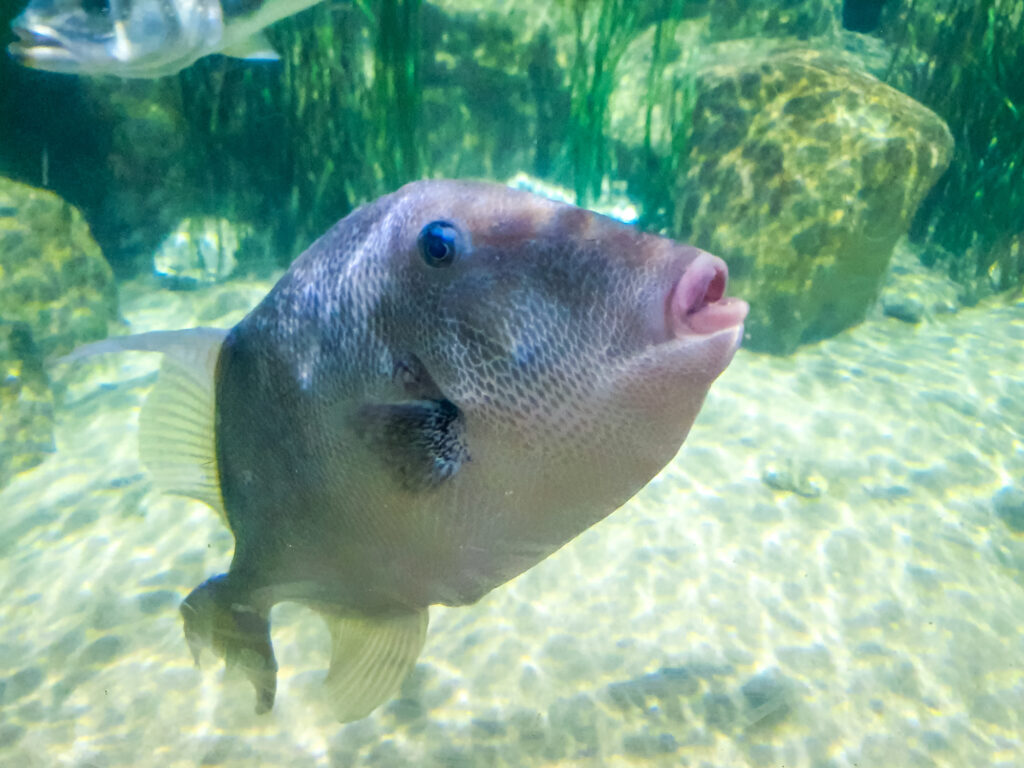We love to showcase all types of marine creatures – the more unusual the better. The grey triggerfish is just that, with its eye-catching appearance and unique abilities. And what’s more, it’s becoming a UK native as increasing sightings of these fish are reported along the southern coasts!
Ready to learn everything you should know about the grey triggerfish? Let’s pull the trigger and get started!
What is a grey triggerfish?
Grey triggerfish (Balistes capriscus) belong to the Balistidae family. There are up to 40 other species of triggerfish known, including the stone triggerfish, which is found in the eastern Pacific and thought to be the largest.
Where does its name come from? Their dorsal fins have a locking mechanism, like a trigger, which is released when the secondary spine is depressed. This means that they can hide in small spaces, ready to defend themselves by shooting out. Not only this, but it also makes them appear more intimidating.
Habitat of grey triggerfish
Originally, grey triggerfish mostly inhabited rocky coral reefs, coastal waters and continental shelf edges in tropical or subtropical areas of the Atlantic and Mediterranean. However, they’re now increasingly spotted further north, swimming around the UK’s shores.
Why are grey triggerfish becoming more common in UK waters?
In recent years, there have been increased sightings of grey triggerfish around southern and western UK coastal areas. Some scientists believe they could be migrating north due to warming seas and the effects of climate change on their cold reef habitats in the Mediterranean.
This is diversifying the UK’s marine biodiversity but could also threaten existing species in these areas due to their aggressive and territorial nature.
How can we protect grey triggerfish in UK waters?

Supporting conservationist efforts to breed this species in captivity, either by volunteering or donating to conservation charities, can help boost their numbers. We must also prevent the species from being overfished in the area, as it has been in other parts of the world for commercial gain. If the demand for private aquarists to own these fish is lower, the risk of overfishing is lower and wild populations can thrive.
Unfortunately, grey triggerfish are currently classified as vulnerable on the IUCN Red List. So, how can we protect their populations?
What do grey triggerfish look like?
Thanks to their unusual characteristics, such as eyes high on their heads, small mouths and a grey-blue colouration, grey triggerfish have a distinctive appearance that’s difficult to mistake. Their bodies are oval-shaped with tough, thick skin, and they’re also well-known for their powerful jaws. They can even camouflage themselves with their surroundings, making them harder for predators to spot.
If you spot one that varies slightly in colouration, you might have come across a juvenile, since these have yellowish bodies with small violet dots. This fades into adulthood, giving them their more subdued hues.
Grey triggerfish grow up to 60cm on average, with males often being bigger than their female counterparts.
What do grey triggerfish eat?
Grey triggerfish are opportunistic omnivores, which means they eat both plants and animals depending on what’s readily available. Their diets mostly consist of sea urchins, crabs, molluscs and other small fish.
Their mouths might be small, but don’t let this fool you – their jaws and teeth are incredibly powerful. These fish use the power of their jaws and the sharpness of their eight teeth to crack shells and crunch down on their prey.
Grey triggerfish behaviours
This fish can be highly territorial, especially during nesting season when they’re fiercely defending their nesting grounds. In fact, they’ve made quite a name for themselves as an aggressive species which charges or bites intruders when protecting nests from other fish or human divers.
You might also spot them gnawing on hard surfaces, which might seem like a strange behaviour, but they have a good reason for doing this. Their teeth grow continuously throughout their lifetime, much like human fingernails, so they need to keep wearing them down before they become unmanageable.
See grey triggerfish at Hastings Aquarium
As well as spotting these fish off the UK coast, you’re guaranteed to find them in Hastings Aquarium’s Native Zone, alongside the European lobster (Homarus gammarus), ballan wrasse(Labrus bergylta), painted ray (Raja microocellata), and many other UK native species.
Why not come along to our world of underwater wonder here at Hastings Aquarium, where you can meet countless other exciting species? Book your tickets in advance to secure your next day out!
